Your 5 Month Old Puppy: Milestones, Training, and Behavior Guide
A 5 month old puppy is a young dog hovering on the brink of maturity. And yet still in many ways a puppy. Today I’m going to talk about my 5 month old Lab puppy Bonnie. I’ll share some photos and video with you. And you’ll find out what you can expect from a puppy this age, in terms of their behavior, training stages and general care.
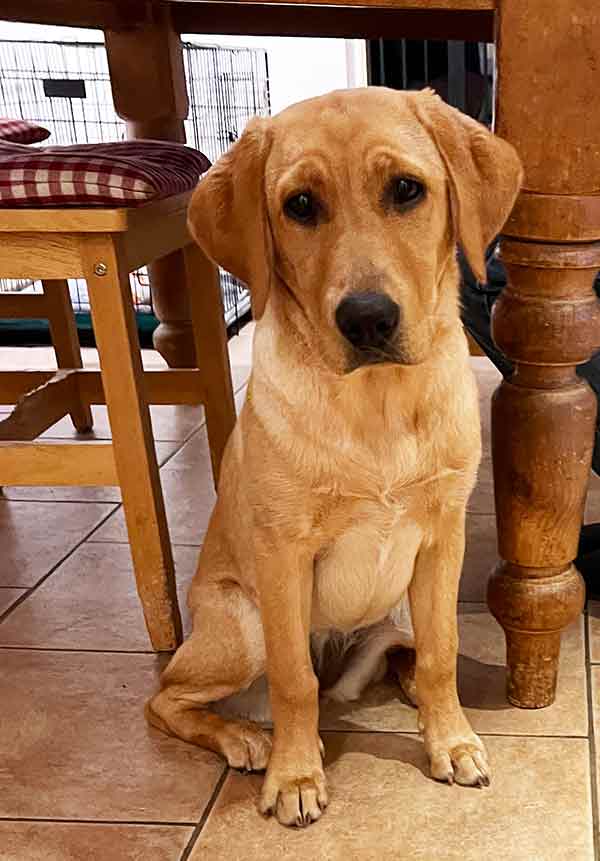
Of course all puppies are different, and your puppy won’t be at exactly the same stage as Bonnie. There’s a broad range of normal, and differences in temperament can have a strong impact on puppy behavior and progress.
Contents
In many ways, a Labrador at five months looks much like an adult Lab on a slightly smaller scale. In some photos its hard to tell that Bonnie is still a puppy. While in others she still looks very young.
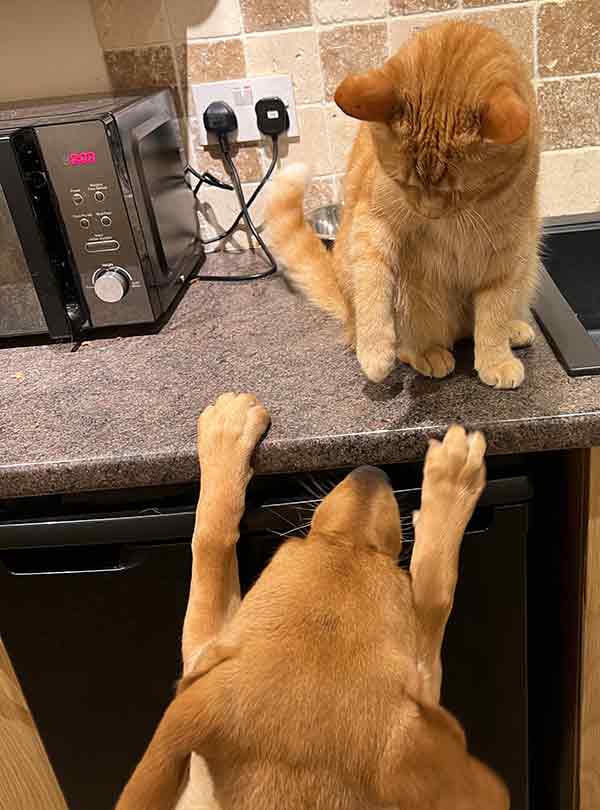
Billy the cat knows she is still a puppy and keeps his mittens on when telling her off!
Feeding a 5 month old puppy
At five months old, many kibble fed puppies will be having three meals a day. One early in the morning, one at lunch time, and one in the evening.
The situation with my Lab pup Bonnie is a little bit different because she is raw fed. A raw fed puppy may not need their daily food ration divided into three portions by this age, and Bonnie has been on two meals a day for a couple of weeks now.
How much to feed?
Feeding quantities will depend on your puppy, and on the brand of food. Some brands have a lot of fillers and quantities required are much higher.
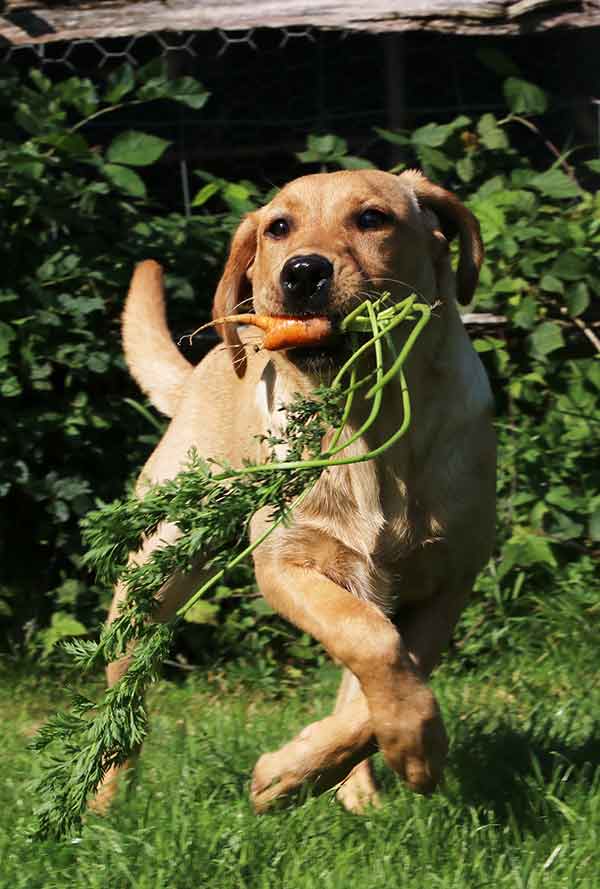
At five months, a puppy should be slim, rather than chubby. Check the manufacturers instructions and reduce by a third for a few days if your puppy is losing their waistline.
You’ll find lots more detail in my puppy feeding guide.
What does a raw fed puppy eat at 5 months old?
At this age Bonnie is now eating what my adult dogs eat. She has a variety of meat during week, including chicken, rabbit, eggs, venison or lamb ribs, heart, lungs and other organs.
Occasionally a wobbly tooth slows her down, but apart from that she manages bones and fur with no problems. Check out my raw feeding page for more information
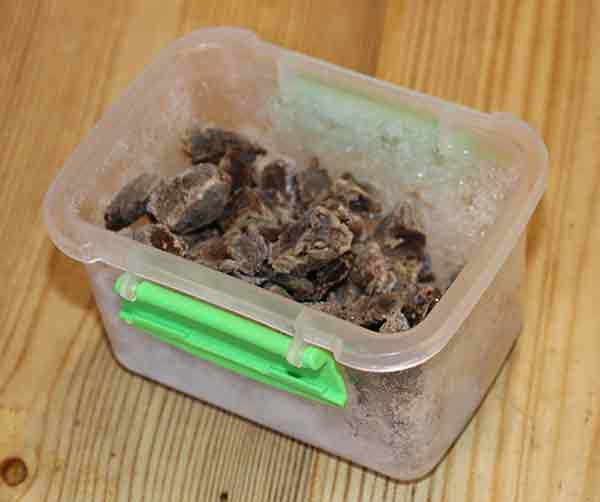
For training treats my Lab puppy has kibble or cubes of roast meat. I prepare these cubes in advance and keep them in little tubs in the freezer. Ten seconds in the microwave brings them up to temperature for training.
5 month old puppy teething stage
Talking of teething, Bonnie now has a lot of her adult teeth. She lost her last wobbly canine just yesterday. It had been hanging on by a thread for a while.
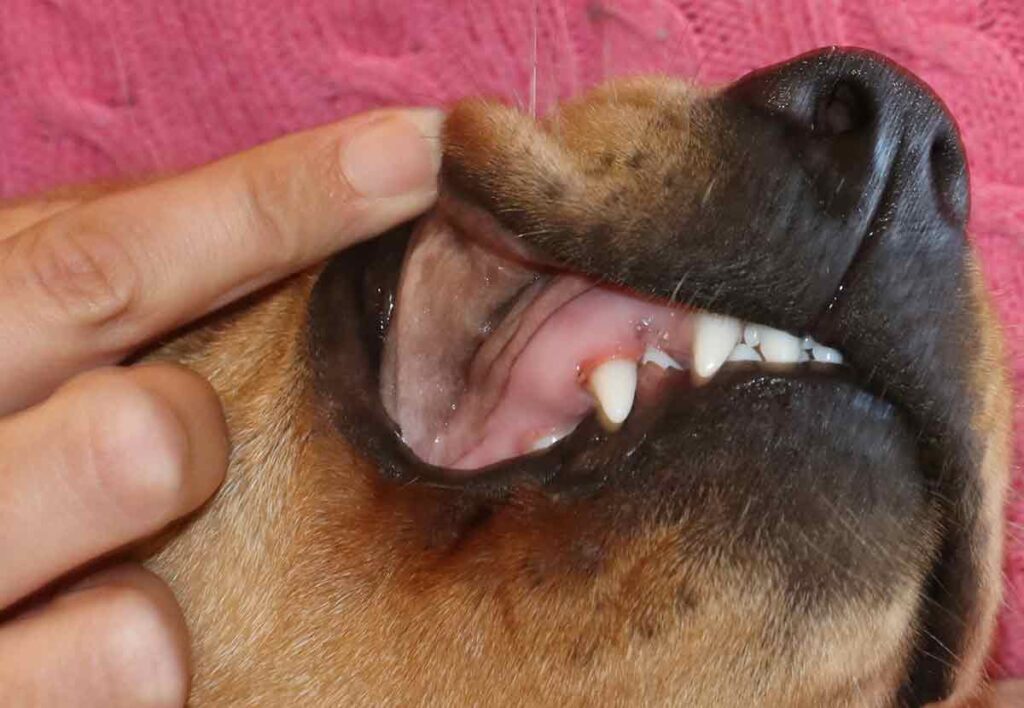
She’ll have a full set of teeth by seven months old, so we are nearly there now.
Do 5 month old puppies bite?
By 5 months old puppy biting should be on the way out. In families where puppies are allowed to engage in rough house play with humans, play biting can be a problem at this age.
If you are finding your puppy is still play biting now, you really do need to change your approach to playing with, and managing, your dog. Have a look at our article on playing with puppies for some ideas and tips.
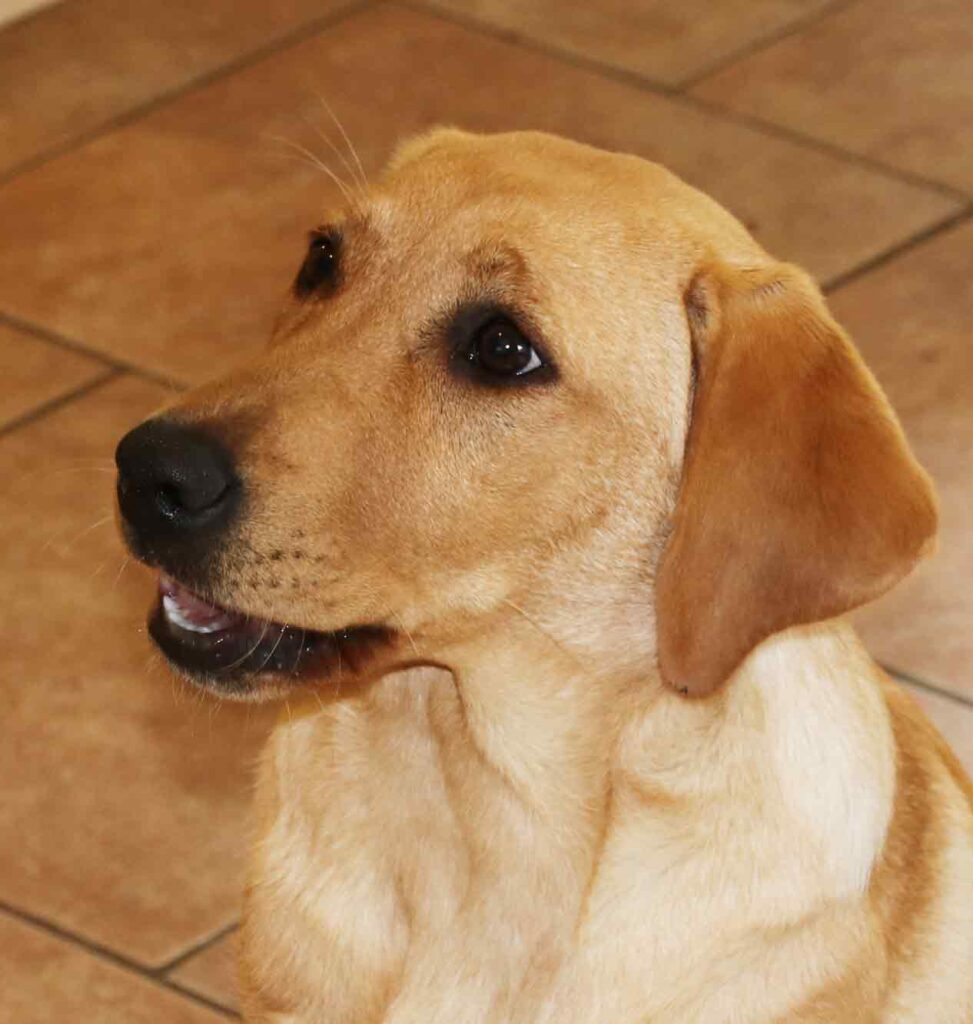
Genetics play a part here too. Bonnie has never been as bitey as many Labrador puppies can be. That’s because she has a very relaxed temperament. She might half heartedly mouth at your hand if you keep messing with her face, but that’s about it.
Potty training progress
We have not had a puddle in the house for a month now, but that does not mean we are completely out of the woods. Accidents, in puppies this age, are common when changes are made to their routines.
If your puppy is still not clean and dry indoors do check out my potty training problems article.
Our back door is currently open for much of the day, and when the weather gets colder and the door is closed I fully expect to have to supervise Bonnie closely to begin with.
Sleeping at night and in the evenings
Labrador puppies are capable of sleeping through an eight hour stretch at night and your puppy should now be able to fit into your family sleep / wake routine.
I find Labradors generally like their beauty sleep. Many like to go back to bed after their early morning pee. And most sleep during the evenings.
All my dogs are encouraged to settle during the evening whilst adults relax. That suits our routine because our dogs have our company all day.
If you like to exercise or play with your dogs in the evening, that’s fine, they’ll catch up on their sleep during the day. You may find they too need a little wind down time before bed.
We are on a homestead with animals to care for, so we are up at five-thirty in the morning and try to be in bed by around ten in the evening. Our dogs go outside for last pees just before ten and are then tucked in for the night in our utility room.
Bonnie still sleeps in a crate while the other dogs are loose.
Crate size and crating at 5 months
Bonnie has just gone up a crate size as her head was touching the roof of the previous one. Her new crate measures 36 inches long by 22 inches deep, by 25 inches tall.
If she still needs a crate in two or three months, she may need to go up another size, that will depend on whether or not she has stopped chewing at that point.
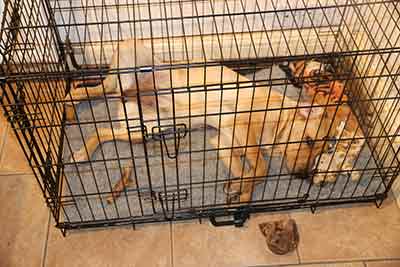
Bonnie is now happy to relax in her crate for an hour or so during the day and we tend to crate her after meals when we are loading the dishwasher.
We also crate her for short periods at other times during the day, just so that she is used to the crate and comfortable being inside it.
I’m currently filming a crate training course with Bonnie and when it’s launched you’ll be able to find this on the Dogsnet Homeschool website.
Training a 5 month old puppy
Five months is the age where a lot of puppy parents start to struggle with their increasingly powerful and boisterous young labs. And you might find it helpful to join our training support group on Facebook
I am teaching Bonnie four key skills at the moment. And I put clips of that training up on the group from time to time.
Those four skills are
- Sit-stay
- Loose leash walking
- Crate confidence
- Recall
Because I am building courses and trying to capture every stage in training on film, Bonnie is behind a lot of 5 month old puppies when it comes to training.
And that’s fine, it isn’t a race, and in a few months time you won’t be able to tell the difference between her, and a dog that was trained earlier. So don’t worry if your training isn’t quite there yet!
Sit and stay at 5 months
Sit-stay is an important skill because a dog that is sitting still is not getting into mischief. They are not jumping up, or running around touching things they shouldn’t.
However, most people get into problems with this by trying to extend the duration of their puppy’s sits, much too fast.
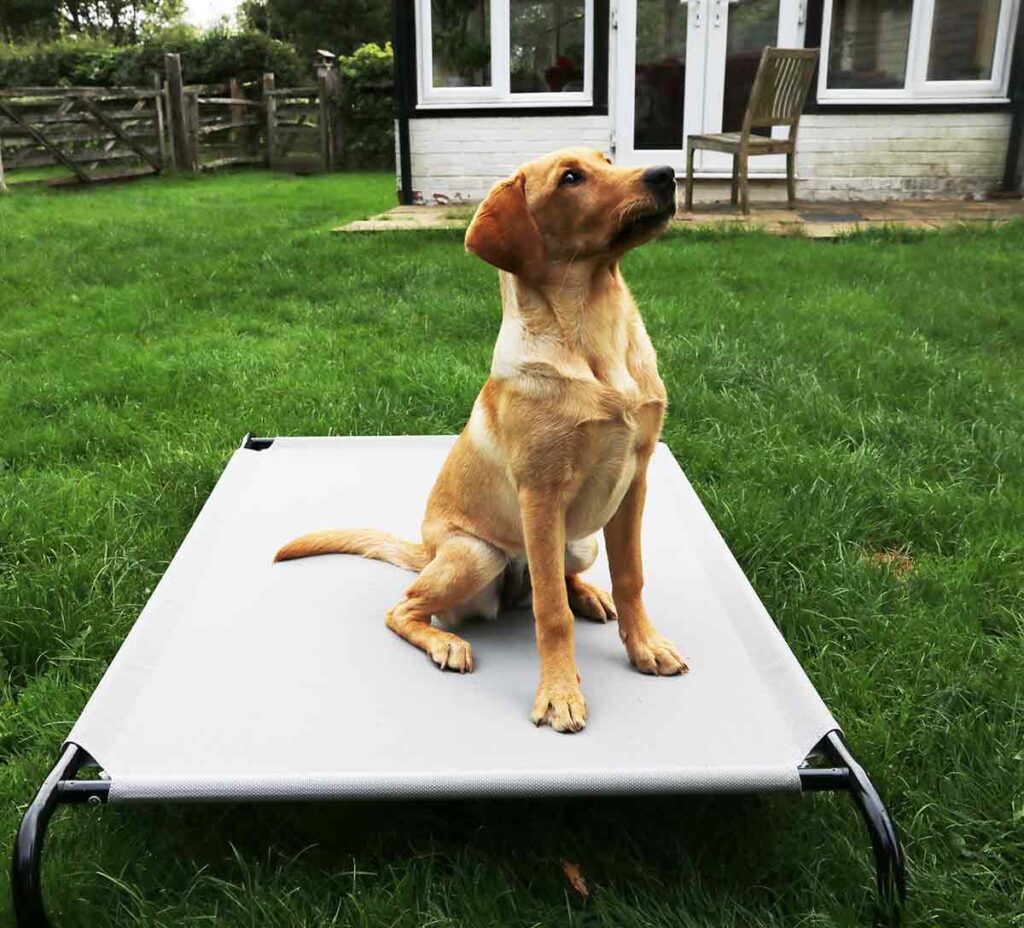
It’s better to build strong foundations and a clear understanding that sit means sit until your are released. Than it is to expect a puppy to hold a sit or a down for ten minutes.
In fact, at this age you need to be thinking in seconds not minutes. Teach a little duration first, say ten seconds, then teach your puppy to sit still while you do things around and to them. For example:
- Can you walk in a circle around your puppy without them getting up?
- Can you take hold of their collar and attach a leash without them moving?
These are the important things at 4-5 months.
Loose leash walking at 5 months old
After reactivity, the most common problem we see causing real distress to families with young labs, is leash pulling.
An adult Lab can weigh 70lbs or more. And, unless you want your arms pulled out of your sockets every time you leave the house, you really do need to get your dog walking nicely next to you before they get any older.
The secret to loose leash walking is to teach the dog to walk at your side without a leash. The added leash then becomes simply another cue to walk nicely. Instead of a cue to drag you to the nearest dog park
You will be able to find more information on this in my loose leash walking course over on Dogsnet
Crate confidence
Although you don’t need a crate in order to manage a 5 month old puppy, I believe that crate confidence is a very useful skill for a dog to have. You never know when your dog might need to be crated in an emergency or during a period of illness.
I teach two aspects of crate training to all my puppies. I teach them to relax in a crate with the door closed. But I also teach them games that involve them jumping in and out of the crate on cue. These games are fun, and build value for being in the crate. You can find them on the Dogsnet Homeschool site.
Recall Training
Everyone wants their dog to come when they are called. It’s a matter of pride, as well as a critical safety and control skill.
Recall often starts out well, most small puppies want to be near their humans, and then goes downhill from there.
When recall fails, it’s usually because the recall cue has been poisoned. That is to say someone, or several someones, have used the cue in a situation where the dog is unwilling to come or where the rewards for coming are non-existent.
I start simple, with minimal use of a recall, and massive rewards for the puppy whenever the recall is heard. At 5 months, Bonnie has never heard the recall cue without there being a significant reward immediately afterwards. A nice meal for example, or a stream of really juicy treats.
Consequently she has never ignored the cue. And my aim is that she never will. You can find out more about recall training and fixing a broken recall, by following that link.
Enjoy your 5 month old puppy
Training at five months is a lot of fun. There should be no pressure on you or your dog. It’s just a question making a plan, and turning up. Do a little each day. five minutes a day will get your dog trained. That’s all it takes!
Enjoy your five month old puppy, it’s a wonderful moment in time and they will be grown up and sensible before you know it.
If you’ve any questions about this article or want to know more about our training methods or Bonnie’s progress, do join the Dogsnet Training Support group over on Facebook. It’s a great community and we’d love to see you there!

Free Labrador Updates!
Get my training tips, news, reviews, and the latest from The Labrador Site delivered to your inbox


